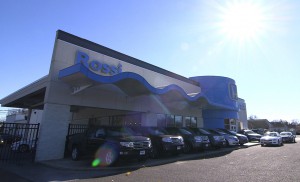With a strong finish, the total new light vehicle sales in 2016 are expected to reach a 17.5 million units, setting a new record and eclipsing the mark set only a year earlier, analysts predict.
Light-vehicle sales in 2016 are expected to reach a record 17.5 million vehicles, surpassing the previous high set in 2015 by 5,000 units, according to a forecast developed jointly by J.D. Power and LMC Automotive.
Deutsche Bank analysts said in a note this week that U.S. auto sales are tracking at a seasonally adjusted annual rate of 17.6 million units in December, up 2.4% year-over-year in absolute units, adjusted for one fewer selling day.
Analysts Rod Lache, Mike Levin and Robert Salmon noted that the rate is close to last month’s 17.8 million-unit rate and the 17.4 million-unit rate for the year-to-date period.
J.D. Power estimated retail sales in 2016 are forecast to close at 14.1 million units, a 1.2% decline from 14.2 million units in 2015, but still will be the sixth-highest retail sales year in history.
New-vehicle retail sales in December are projected to reach 1.33 million units, a 0.8% increase on a selling-day adjusted basis compared with December 2015, while total light-vehicle sales are expected to reach 1.6 million units, a 1.4% increase.
Jeff Schuster, senior vice president of forecasting at LMC Automotive, said 2016 is expected to be another record for light-vehicle sales, “but it will come down to a photo finish.”
Given the high level of incentives and an increase in fleet volume this year, we expect to see some payback in 2017, Schuster said.
(Gas prices marching upward as OPEC production cuts loom. For more, Click Here.)
“Positive drivers include a stronger economy with fiscal stimulus and deregulation, Volkswagen’s buyback program and a high number of lease maturities. Negative drivers include a steeper interest rate increase, potential protectionism, a potential pullback in incentive levels and used-car substitution,” he added.
“This year will be remembered for strong retail sales and record transaction prices. However, elevated inventories, a slow model-year transition and record incentive levels point to the challenges the industry will face in 2017. Going forward, automakers must maintain production and pricing discipline to achieve profitability, which is easier said than done,” noted Deirdre Borrego, J.D. Power senior vice president and general manager of automotive data and analytics.
Incentive spending in November eclipsed $4,000 per unit for the first time on record. December, which typically delivers the highest incentive spending level of the year, is expected to exceed the November record as manufacturers clear out old model-year vehicles and reduce inventory, the J.D. Power report noted.
The average new-vehicle retail transaction price thus far in December is $32,000, a record for the month, and surpassing the previous high of $31,849 set in December 2015.
(Toyota owners keep their vehicles longer, study shows. Click Here for details.)
Fleet sales are expected to total 271,700 units in December, up 4.8% on a selling-day adjusted basis from December 2015. Fleet volume is expected to account for 16.9% of total light-vehicle sales, up slightly from 16.4% in December 2015.
With high absolute retail sales volumes and record transaction prices for the month, consumers are on pace to spend $42.6 billion on new vehicles in December, slightly behind the record high of $43.7 billion for the month of December set in 2015. Additionally, 2016 annual retail sales expenditures will set a record at $438 billion, surpassing the previous record of $436 billion set in 2015.
LMC is forecasting total light-vehicle sales in 2017 to be in the 17.4-17.5 million-unit range, down slightly from 2016 levels by approximately 25,000 units. Retail light-vehicle sales are expected to fall 0.3% to 14 million units in 2017.
For 2017, Deutsche Bank expects U.S. light vehicle sales of 17.4 million units, flat with last year, with higher fleet sales being the bright spot.
(Nearly 700 deaths expected on U.S. roads during holiday weekends. Click Here for the story.)
Notwithstanding incentives rising to 10.6% of the ATP versus 9.9% in 2015, the firm noted that retail sales have lagged. Although the firm expects a sales decline in 2017 to 17 million units, it believes the risks of an industry downturn for the next year or two has reduced, given that the prospects for U.S. economic growth.

